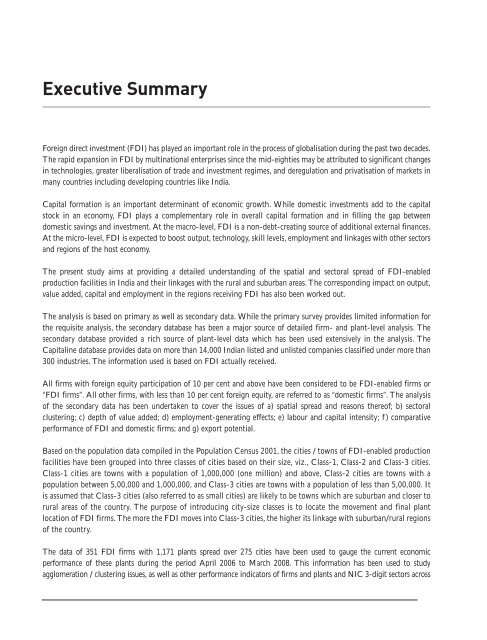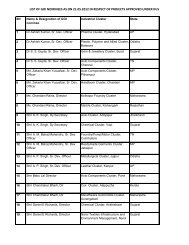fdi in india and its growth linkages - Department Of Industrial Policy ...
fdi in india and its growth linkages - Department Of Industrial Policy ...
fdi in india and its growth linkages - Department Of Industrial Policy ...
You also want an ePaper? Increase the reach of your titles
YUMPU automatically turns print PDFs into web optimized ePapers that Google loves.
Executive Summary<br />
Foreign direct <strong>in</strong>vestment (FDI) has played an important role <strong>in</strong> the process of globalisation dur<strong>in</strong>g the past two decades.<br />
The rapid expansion <strong>in</strong> FDI by mult<strong>in</strong>ational enterprises s<strong>in</strong>ce the mid-eighties may be attributed to significant changes<br />
<strong>in</strong> technologies, greater liberalisation of trade <strong>and</strong> <strong>in</strong>vestment regimes, <strong>and</strong> deregulation <strong>and</strong> privatisation of markets <strong>in</strong><br />
many countries <strong>in</strong>clud<strong>in</strong>g develop<strong>in</strong>g countries like India.<br />
Capital formation is an important determ<strong>in</strong>ant of economic <strong>growth</strong>. While domestic <strong>in</strong>vestments add to the capital<br />
stock <strong>in</strong> an economy, FDI plays a complementary role <strong>in</strong> overall capital formation <strong>and</strong> <strong>in</strong> fill<strong>in</strong>g the gap between<br />
domestic sav<strong>in</strong>gs <strong>and</strong> <strong>in</strong>vestment. At the macro-level, FDI is a non-debt-creat<strong>in</strong>g source of additional external f<strong>in</strong>ances.<br />
At the micro-level, FDI is expected to boost output, technology, skill levels, employment <strong>and</strong> l<strong>in</strong>kages with other sectors<br />
<strong>and</strong> regions of the host economy.<br />
The present study aims at provid<strong>in</strong>g a detailed underst<strong>and</strong><strong>in</strong>g of the spatial <strong>and</strong> sectoral spread of FDI-enabled<br />
production facilities <strong>in</strong> India <strong>and</strong> their l<strong>in</strong>kages with the rural <strong>and</strong> suburban areas. The correspond<strong>in</strong>g impact on output,<br />
value added, capital <strong>and</strong> employment <strong>in</strong> the regions receiv<strong>in</strong>g FDI has also been worked out.<br />
The analysis is based on primary as well as secondary data. While the primary survey provides limited <strong>in</strong>formation for<br />
the requisite analysis, the secondary database has been a major source of detailed firm- <strong>and</strong> plant-level analysis. The<br />
secondary database provided a rich source of plant-level data which has been used extensively <strong>in</strong> the analysis. The<br />
Capital<strong>in</strong>e database provides data on more than 14,000 Indian listed <strong>and</strong> unlisted companies classified under more than<br />
300 <strong>in</strong>dustries. The <strong>in</strong>formation used is based on FDI actually received.<br />
All firms with foreign equity participation of 10 per cent <strong>and</strong> above have been considered to be FDI-enabled firms or<br />
“FDI firms”. All other firms, with less than 10 per cent foreign equity, are referred to as “domestic firms”. The analysis<br />
of the secondary data has been undertaken to cover the issues of a) spatial spread <strong>and</strong> reasons thereof; b) sectoral<br />
cluster<strong>in</strong>g; c) depth of value added; d) employment-generat<strong>in</strong>g effects; e) labour <strong>and</strong> capital <strong>in</strong>tensity; f ) comparative<br />
performance of FDI <strong>and</strong> domestic firms; <strong>and</strong> g) export potential.<br />
Based on the population data compiled <strong>in</strong> the Population Census 2001, the cities / towns of FDI-enabled production<br />
facilities have been grouped <strong>in</strong>to three classes of cities based on their size, viz., Class-1, Class-2 <strong>and</strong> Class-3 cities.<br />
Class-1 cities are towns with a population of 1,000,000 (one million) <strong>and</strong> above, Class-2 cities are towns with a<br />
population between 5,00,000 <strong>and</strong> 1,000,000, <strong>and</strong> Class-3 cities are towns with a population of less than 5,00,000. It<br />
is assumed that Class-3 cities (also referred to as small cities) are likely to be towns which are suburban <strong>and</strong> closer to<br />
rural areas of the country. The purpose of <strong>in</strong>troduc<strong>in</strong>g city-size classes is to locate the movement <strong>and</strong> f<strong>in</strong>al plant<br />
location of FDI firms. The more the FDI moves <strong>in</strong>to Class-3 cities, the higher <strong>its</strong> l<strong>in</strong>kage with suburban/rural regions<br />
of the country.<br />
The data of 351 FDI firms with 1,171 plants spread over 275 cities have been used to gauge the current economic<br />
performance of these plants dur<strong>in</strong>g the period April 2006 to March 2008. This <strong>in</strong>formation has been used to study<br />
agglomeration / cluster<strong>in</strong>g issues, as well as other performance <strong>in</strong>dicators of firms <strong>and</strong> plants <strong>and</strong> NIC 3-digit sectors across












